Research Article
Electrolyte Effects on Polyacrylic Acid-Polyvinylpyrrolidone Aqueous Glycol Mixtures for Use as De-Icing Fluids
Yuchen Wang1, Richard A Pethrick2, Nicholas E Hudson2 and Carl J Schaschke3*
1Department of Chemical and Process Engineering, University of Strathclyde, Glasgow, Scotland, UK
2Department of Pure and Applied Chemistry, University of Strathclyde, Glasgow, Scotland, UK
3School of Science, Engineering and Technology, Abertay University, Dundee, Scotland, UK
- *Corresponding Author:
- Carl J Schaschke
School of Science
Engineering and Technology
Abertay University, Dundee
Scotland DD1 1HG, UK
Tel: 0044(0)1382308488
E-mail: c.schaschke@abertay.ac.uk
Received date: January 27, 2016; Accepted date: February 01, 2016; Published date: February 06, 2016
Citation: Wang Y, Pethrick RA, Hudson NE, Schaschke CJ (2016) Electrolyte Effects on Polyacrylic Acid-Polyvinylpyrrolidone Aqueous Glycol Mixtures for Use as De-Icing Fluids. Ind Chem 2:115. doi:10.4172/2469-9764.1000115
Copyright: © 2016 Wang Y, et al. This is an open-access article distributed under the terms of the Creative Commons Attribution License, which permits unrestricted use, distribution, and reproduction in any medium, provided the original author and source are credited.
Abstract
Rheological and wind tunnels measurements are presented for mixtures of polymer polyacrylic acid [PAA] and polyvinylpyrrolidone [PVP] polymers dispersed in water-1,2 propylene glycol mixture to examine their use as potential aircraft de-icing fluids. PAA solutions which form the basis of de-icing fluids are known to result in undesirable gelation which may lead to undesirable and catastrophic consequences in such applications. In this study, we examine the blending of PVP with PAA blends as alternative de-icing fluid formulations that can reduce the likelihood of forming such irreversible gel deposits. Through adjustment of the electrolyte concentration, the ratio of PAA to PVP as well as the molecular weight of PVP, it is possible to achieve a required viscosity profile to that exhibited by a model de-icing fluid across a range of appropriate temperatures. Wind tunnel tests indicate that the mixtures are capable of meeting the necessary requirements for boundary layer depletion as well as having sufficient capability of retaining a stable layer required during aircraft taxiing.

 Spanish
Spanish  Chinese
Chinese  Russian
Russian  German
German  French
French  Japanese
Japanese  Portuguese
Portuguese  Hindi
Hindi 